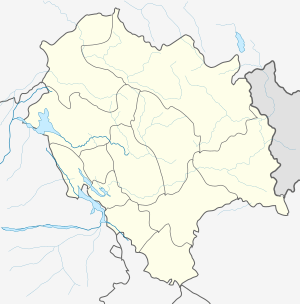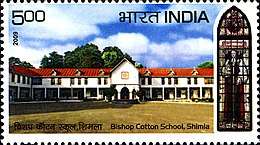Bishop Cotton School (Shimla)
Bishop Cotton School is a boarding school in Shimla, Himachal Pradesh. It is one of the oldest boarding schools for boys in Asia,[1] having been founded on 28 July 1859 by Bishop George Edward Lynch Cotton. Bishop Cotton also founded the Bishop Cotton School, Nagpur. The alumni of Bishop Cotton are known as Old Cottonians. The Bishop Cotton School, Shimla celebrated 150 years of existence in 2009.[2]
| Bishop Cotton School | |
|---|---|
School crest | |
| Location | |
 Bishop Cotton School  Bishop Cotton School | |
Knollswood, Shimla, Himachal Pradesh India | |
| Coordinates | 31.0853°N 77.1736°E |
| Information | |
| Type | Independent boys-only boarding school |
| Motto | Overcome Evil With Good |
| Established | 1859 |
| Founder | Bishop George Edward Lynch Cotton |
| Head of school | Simon Weale |
| Grades | Class 3–12 |
| Number of students | approx. 500 |
| Campus size | 23 ha (56 acres) |
| Houses | Curzon, Ibbetson, Lefroy and Rivaz |
| Colour(s) | Cambridge blue and Oxford blue |
| Affiliation | Indian Certificate of Secondary Education Examination (ICSE) and The Indian School Certificate examination (ISC) |
| Alumni name | Old Cottonians |
| Website | bishopcottonshimla |
The school has produced army officers, ambassadors, judges, ministers, and politicians.
Bishop Cotton School has been ranked among the best boys-only residential schools of India by media such as The Times of India, Outlook, and Education World.[3]
History
Bishop George Edward Lynch Cotton was a scholar of Westminster, and a graduate of Cambridge University.[4] In 1836 he was appointed Assistant Master at Rugby School by Doctor Thomas Arnold, one of the founders of the British public school system. It was the young Mr. Cotton who was spoken of as 'the model young master' in Thomas Hughe's famous book 'Tom Brown's School Days'. The school opened for students on 15 March 1863. Though mentioned in correspondence as the Simla Public School, it never actually bore this name. The first boy, Frederick Naylor, joined the school on 16 March 1863. Bishop Cotton reconnoitred ten sites in September and October 1864, and finally approved the South end of Knollswood Spur which belonged to the Rajah of Keonthal. After negotiations the site was acquired through the intervention of the Viceroy and the foundation stone for the new buildings was laid on 26 September 1866, by the Viceroy, Sir John Lawrence, brother of Sir Henry Lawrence, founder of the famous Lawrence School, Sanawar. In September 1868, the school moved to Knollswood, the present site. Bishop Cotton was inspired by the phrase, "Overcome Evil With Good" from Romans 12:21.
Head Masters[5]
- The Rev. S. Slater D.D. (1863-1885)
- The Rev. H.M. Robinson (1885-1886)
- The Rev. E.A. Iron MA (1887-1901)
- The Rev. H.M. Lewis MA (1901-1918)
- The Rev. R.R. Gillespy (1919-1922)
- The Rev. W.S. O’Neil MA (1923-1926)
- The Rev. J.R. Peacy MA, MC (1927-1935)
- The Rev. Canon G. Sinker MA (1935-1945)
- The Rev. F.M. Drake BA, BT (1946-1949)
- Mr. F.H. Fisher BA, BT (1949-1953)
- Mr. E.G. Carter OBE, MA (1956-1957)
- Dr. T.M. Dustan, MA, BD, DD (1958-1962)
- Major R.K. Von Goldstein MBE, MA (1963-1976)
- Brig. S.J. Mukand MA LT, DP Ed (1976-1986)
- Mr. R.N. Hakim MA LT (1986-1993)
- Mr. Kabri Mustafi MA, B.Ed (1994-2004)
- Mr. Roy Christopher Robinson M.A, B.Ed, T.T.C (2004-2019)
- Mr. Simon Weale M.A Oxon (Current)[6]
School organisation
House system
The four houses are named after people who provided financial help to the school after The Great Fire of 1905.
- Curzon House – founded in 1909, motto Facta Non Verba. was named after Lord Curzon, the Viceroy of India (1899–1905).
- Ibbetson House – founded in 1907, motto Nec Impetu Nec Imperio, was named after Denzil Ibbetson, the Governor of Punjab (1907–1908).
- Lefroy House – founded in 1906, motto Mutare Sperno), was named after George Lefroy, the third Bishop of Lahore.
- Rivaz House – founded in 1908, motto Servamus, was named after Charles Montgomery Rivaz, the Governor of Punjab (1903–1907)
House Masters
In the Junior School, from classes III to V, pastoral requirements are met and control and supervision of the boys is by the matrons who live next to the boys in the dormitories. The children have class teachers who function like house tutors for the children of their classes.
Prefectorial System
Bishop Cotton School was again the first school in India to start the Prefectorial System. Today, the school authorities consist of the four house captains, the school captain, and the school prefect.
Curriculum

The school has its own curriculum for classes III to VIII. Classes IX to XII follow the CISCE syllabus.
Every boy goes on for tertiary education at the end of year XII, and the success rate for the board examination is usually 100%. The teaching system is backed by a remedial address system, and since the boys and staff are residents, every teacher is accessible at any time if a child seeks help. The school has provisions for helping children with special needs. The school runs The Learning Centre, which is an education centre for non-resident, intellectually-challenged children of Shimla town.
Buildings and grounds
The staff are housed in Linlithgow house. Next to this is the Holy Trinity Chapel and between them is Canning Gate and Lawrence Gate which can be identified with The Lawrence School, Sanawar crest bearing the legend "Be ready". Viceroy Lawrence laid the foundation stone of the school at the present site.
Facing the main school building are Rivaz, Ibbetson and Lefroy dormitory houses. Curzon dormitory house is at the right back end. Opposite Lefroy is the War Memorial and Museum with a cannon and an aircraft further along. Between Lefroy and the War Memorial is an arched hedge that leads past a tiny rose garden to the Headmaster's Lodge and the Lady Willingdon Swimming Bath. In front of the porch is a fountain commemorating Sardar Sohan Singh.
The main hall of the school is Irwin Hall. Behind this is the Senior Master's Lodge to the left of which is the park and to its right Litster Hall and the laboratories. Sports facilities include the Bawa Squash Courts and Shankar Hall for indoor badminton.
Dormitories
From classes 3 to 8 the boys live in dormitories under the care and supervision of Matrons, boys of the same age group are together. The Remove Building commemorates Ronald and Zoe Hakim (Staff 1969–86; HM: 1987–94). Each dormitory has about 34 boys. Class III and IV lives in Linlithgow, Class V lives in Iron's Dormitory, Class VI lives in Sinker Dormitory, VII lives Stooks and Class VIII lives in Lewis Dormitory. Dormitory From class IX the boys move up to the Main School, which dates back to the 1860s, and live in their Houses with all boys of a particular house together. They are under the direct control and supervision of their House Masters, Captains and Prefects.
Old Cottonians Association
The OCA was started in 1910 when 17 Old Cottonians assembled in the Freemason's Hall in Shimla. The Old Cottonians Association is spread all over the world.
Notable alumni
- Lieutenant General N C Rawlley, former Vice Chief of the Army Staff (India)
- H. S. Bedi, Justice, Supreme Court of India
- Colonel Reginald Edward Harry Dyer[7], The Butcher of Amritsar
- General Akhtar Abdur Rahman, military governor of Baluchistan and head of Inter-Services Intelligence, Pakistan
- Sir Palden Thondup Namgyal 12th and the last king of Kingdom of Sikkim
- DIG Simranjit Singh Mann, MP, Punjab (Ibbetson 1951–61)
- William Kirkpatrick, MP for Preston (Conservative), 1931 (1891–96)
- Maj Roy Farran, DSO, MC with Two Bars, served with 3rd Squadron, 2 SAS During World War II in Italy, France, and Norway. Post war MLA, Minister of Utilities and Telephone, Canada (Curzon 1932–34)
- Fali Nariman, Senior Advocate Supreme Court of India, MP (Rajya Sabha), Padma Bhushan (Ibbetson 1942–44)
- Virbhadra Singh (Ibbetson 1947–51), former Chief Minister of the Indian state of Himachal Pradesh, member of the Indian National Congress.
- A. S. Dulat, former R&AW chief
- Montek Singh Ahluwalia, Indian economic policy-maker, Cabinet Minister
- Sukhpal Singh Khaira, member of the Legislative Assembly, Punjab, India.
- Ruskin Bond, Padma Shri, Indian author, awarded Padma Shri in 1999 for contributions to children's literature
- Jeev Milkha Singh, Indian professional golfer who became the first player from India to join the European Tour in 1998, and four-time winner on European Tour
- Kumar Gaurav, actor
- Lalit Modi, Chairman and Commissioner of IPL
- Bob Singh Dhillon, Indo-Canadian multi-millionaire businessman
- Ratan Tata, business tycoon
- Junaid Azim Mattu, politician and mayor of Srinagar
- Mayank Dagar, Indian cricketer who plays for Kings XI Punjab
- Tarsem Singh Dhandwar, director
- Benjamin Gilani, actor
See also
References
- "Bishop Cotton School in Shimla stands test of time". Hindustan Times. 10 September 2018. Retrieved 31 October 2019.
- "The Tribune, Chandigarh, India - Himachal PLUS". m.tribuneindia.com. Retrieved 28 April 2020.
- "3 School Rankings of 2012". Education World. Archived from the original on 15 January 2013. Retrieved 8 January 2013.
- "Our Heritage and History". BISHOP COTTON SHIMLA. Retrieved 28 April 2020.
- "Headmaster's Lodge". BISHOP COTTON SHIMLA. Retrieved 28 April 2020.
- Service, Tribune News. "Simon Weale is director of Shimla's Bishop Cotton School". Tribuneindia News Service. Retrieved 4 May 2020.
- Service, Tribune News. "The 'Evil Cottonian' who let the school down". Tribuneindia News Service. Retrieved 2 March 2020.
External links
- The Schools Globe, a community whose members are from 15 boarding schools of India, thus forming 'The Prestigious Schools Club' (Bishop Cotton School – Shimla)
- Cottonians Connect, a website created by the Cottonian fraternity
- Old Cottonians Association